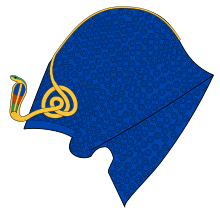Chepresch
| Blue crown in hieroglyphics | |||||
|---|---|---|---|---|---|
|
|||||
Chepresch Chprsh Blue Crown or War Crown |
|||||
The Chepresch (also blue crown or war crown , war helmet ) is an ancient Egyptian headgear and part of the regalia of the child gods and the kings ( pharaohs ). At the end of the Second Intermediate Period, the crown appeared in relief , and later also in round sculptures .
Representations
The Chepresch refers to a helmet-like, arched crown made of leather, metal or fabric of blue, rarely also black, which was often provided with numerous small gold discs and on the forehead, similar to the Nemes headscarf , with a uraeus snake .
From the 18th dynasty onwards , the Chepresch crown was a particular feature of kings. In Greco-Roman times it was often used in the image programs as the headgear of the pharaohs. In addition, since the beginning of the Ptolemaic rule , the Chepresch crown was increasingly used in the iconographic representations of child deities, for example in Hor-pa-chered .
Mythological connections
In Egyptological research, the Chepresch crown was interpreted as a war crown for a long time. However, recent research shows that the use was diverse and not limited to acts of war. Although it was often used in the image programs relating to the victory over the enemies of Egypt, other crowns are also documented in this context. In addition, the king very often wore the blue crown when he was seen as a child, especially when breastfeeding by goddesses. This gives a direct connection to the child deities, who also appeared in similar phenomena.

Symbolically , the Chepresch crown probably served for renewal and fertility (see name, Cheperer hieroglyph and god Chepre ) and as a sign of the rightful heir who asserts his legitimate claim to heir to the throne. The commonality between kings and child gods with regard to the Chepresch crown was that only the king and the respective child god wore the blue crown as a sign of rule over Egypt; the king as a sign of earthly and the child god as a symbol of divine rule.
See also
literature
- Georg Steindorff : The blue royal crown . In: Georg Steindorff (Hrsg.): Journal for Egyptian language and antiquity . Fifty-third volume. Hinrichs'sche Buchhandlung, Leipzig 1917, p. 59–74 ( digitized version [accessed April 13, 2016]).
- Wolfgang Helck , Eberhard Otto : Small Lexicon of Egyptology. 4th, revised edition. Harrassowitz, Wiesbaden 1999, ISBN 3-447-04027-0 , pp. 157-158.
- Sandra Sandri: Har-Pa-Chered. = (Harpocrates). The genesis of an Egyptian child of gods (= Orientalia Lovaniensia analecta vol. 151). Peeters, Leuven 2006, ISBN 90-429-1761-X .

